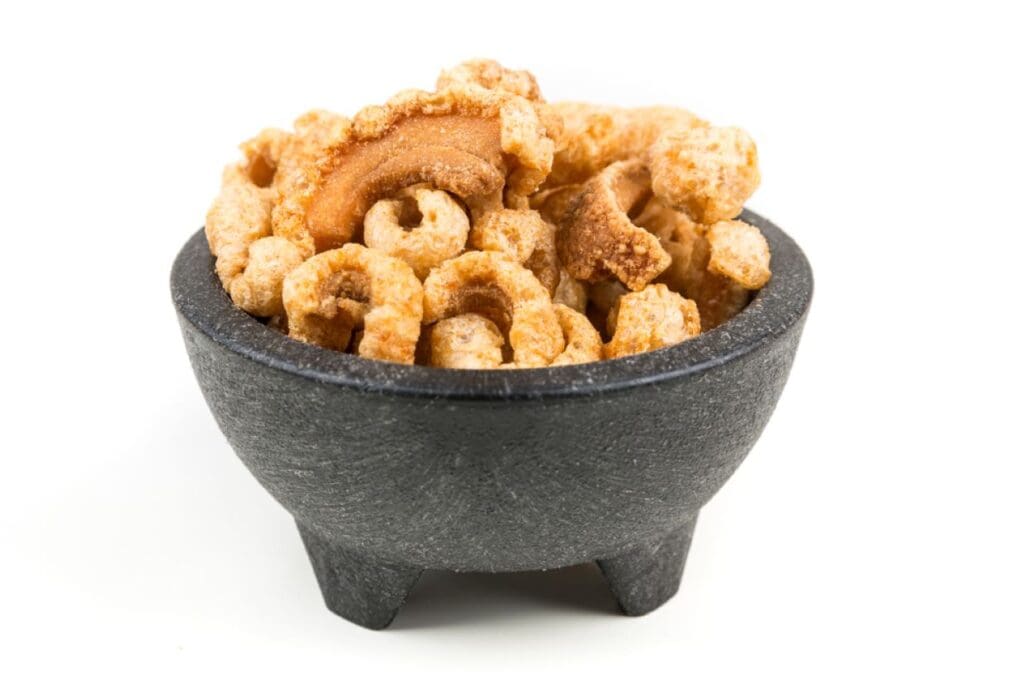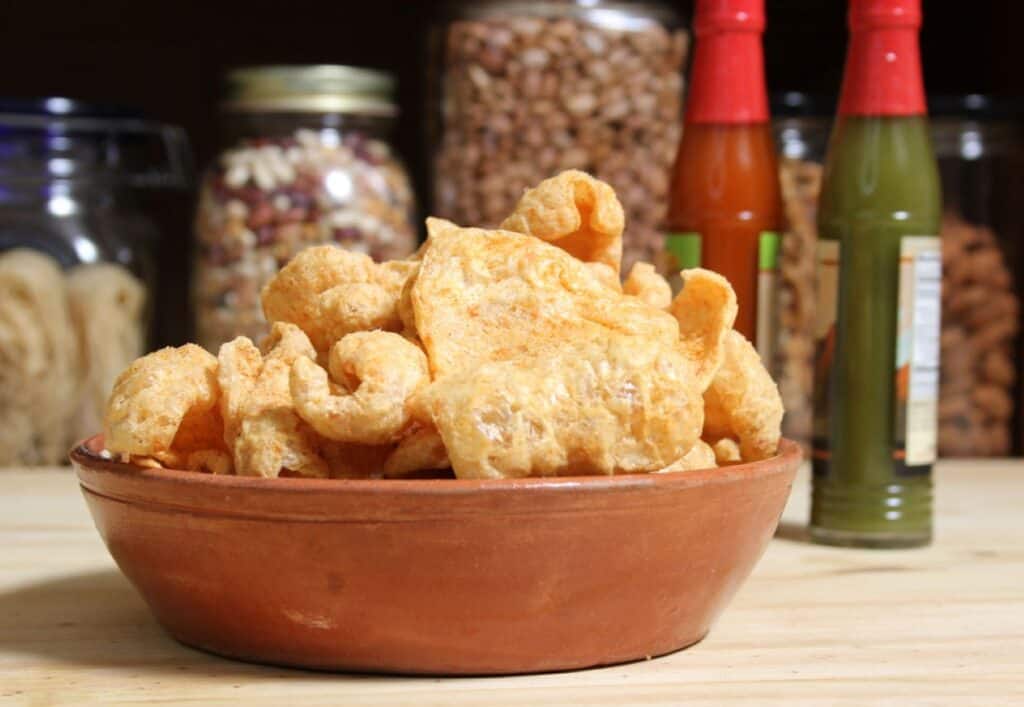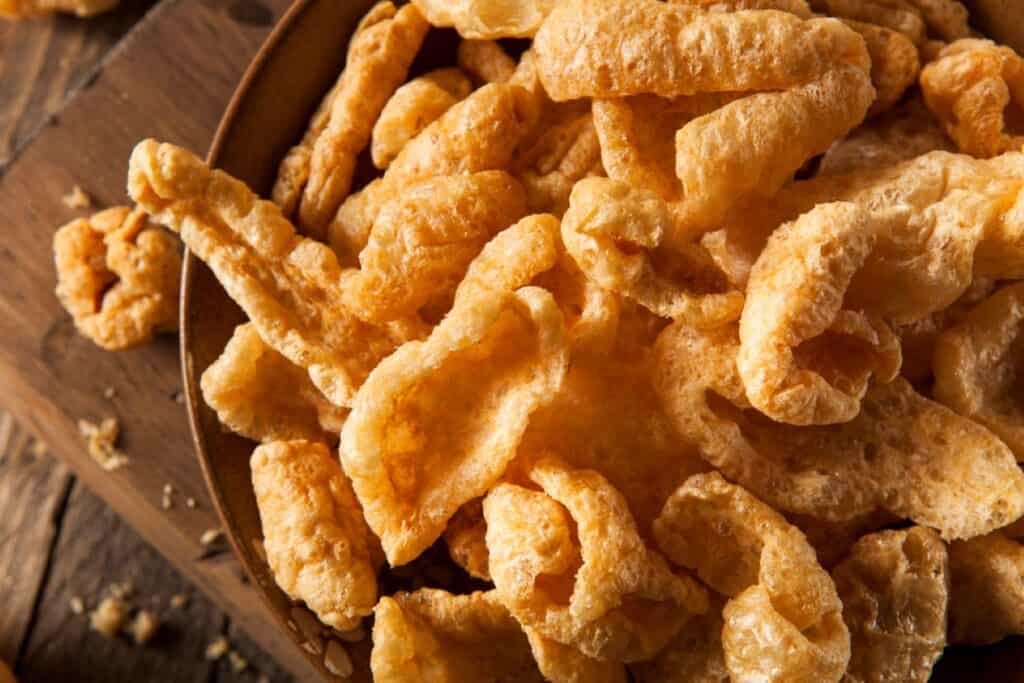Pork rinds have long been a topic of debate in health circles. This snack, known for its crunchy texture and rich flavor, offers more than meets the eye.

These statements have not been evaluated by the Food and Drug Administration. Please see the disclaimer below for more information.
Pork rinds, traditionally known as “chicharrones”, are crispy snacks made from slices of pig skin that undergo a cooking process transforming them into puffy and crunchy bites. They’re often associated with various global cuisines and hold particular popularity in regions such as North America, Latin America and parts of Europe.
Pork rinds, with their unique texture and flavor, have become a staple in the world of snacking. They offer a satisfying crunch, whether eaten straight from the bag, used as a crunchy salad topping or incorporated into recipes for an added texture. They are a definite pantry essential.
What pork rinds are
If you are asking yourself, ‘Are pork rinds healthy?’ or ‘What are pork rinds?’ then you are not alone. The appeal lies in their rich, savory flavor, making them a favorite among snack enthusiasts as well as those following specific diets like a keto or low-carb diet.

The taste of pork rinds can vary significantly depending on how they are seasoned. Plain pork rinds have a subtle, meaty flavor with a hint of saltiness. However, they are often available in a variety of flavors ranging from spicy to tangy to barbecue. In different parts of the world, pork rinds are enjoyed in different ways — some enjoy them with hot sauce, while others might pair them with a creamy dip or incorporate them into recipes for added crunch.
Production and manufacturing
Commercial pork rinds undergo a meticulous production process to transform pork skin into the light and crispy snack many enjoy. The primary ingredient for pork rinds is pork skin. In large-scale manufacturing, producers often use frozen and dried pork skin pellets, which they simmer in water to rehydrate. After simmering, the skins are air-dried to achieve the proper texture before the frying process. For seasoning, a variety of spices can be added depending on the desired flavor profile.
- Rehydration: Simmering in water to prepare for frying.
- Drying: Air-dried post-simmering to remove moisture.
- Seasoning: Application of spices for flavor.
Nutritional information
When considering whether pork rinds are healthy, it is important to look at the nutritional profile. Pork rinds are notable for their high protein and zero carbohydrate content. A standard serving size of pork rinds can provide a significant amount of protein, essential for muscle repair and growth. For instance, a 0.5-ounce serving typically contains about 9 grams of protein and 5 grams of fat.
Nutrient Amount per 0.5-ounce serving
Calories 80 kcal
Protein 9 g
Total Fat 5 g
Saturated Fat Varied
Carbohydrates 0 g
Dietary Fiber 0 g
Cholesterol Varied
The consensus on whether pork rinds are healthy or not
Pork rinds are a source of collagen, which can be beneficial for skin and joint health. Consumers tend to compare pork rinds with other snacks, and while they may have fewer carbohydrates, they are not a low-calorie or low-fat option. This is important if monitoring calories or fat consumption is important for dietary needs. Eating too much higher-calorie foods can lead to weight gain. Nonetheless, as with all foods, individuals should assess their overall diet and health goals when incorporating pork rinds into their eating habits.
Filled with appetizers, salads, sides, mains and desserts, Food Drink Life's cookbook will become your favorite!
- Easy and delicious recipes from a variety of top chefs and recipe developers.
- Bright, colorful pictures on every page.
- Printer-friendly recipes that you can download instantly to your device.
- Printable shopping list and a kitchen conversion sheet.
Why low-carb dieters turn to pork rinds
The journey of a low-carb dieter is filled with the search for satisfying snacks that meet their dietary needs without compromising on taste. Among the various options available, pork rinds have emerged as a favorite and are favored among healthy snacks.
Carb-free snacking
One of the most significant advantages of pork rinds for low-carb dieters is their carb content, or rather, the lack of it. Unlike many other snacks that are laden with carbohydrates, pork rinds contain zero carbs. This makes them an ideal choice for those following keto diets, Atkins diets, or any other low-carb eating plan where keeping carbohydrate intake to a minimum is crucial.
High in protein
Pork rinds are not just low in carbs, they’re also high in protein. As discussed, protein is an essential macronutrient that helps build muscle, repair tissues, and make you feel fuller for longer. For low-carb dieters, especially those who are also active or trying to build muscle, pork rinds provide a convenient and tasty way to increase protein intake.
Satisfying crunch and flavor
Dieting can be hard, especially when it comes to giving up certain textures and flavors. Pork rinds fill a specific niche by providing a crunchy texture that many dieters miss when they cut out high-carb foods like chips and crackers. Moreover, with the variety of flavors available, pork rinds can satisfy a range of taste preferences.
Pork rind uses
Pork rinds can be used in just about anything, as seen in this collection of pork rind recipes for snacks, desserts and savory meals. A common use of pork rinds is as a substitute for breadcrumbs or almond flour when preparing breaded dishes or casseroles such as this chicken noodle casserole. These crispy morsels bring a unique texture, delivering a satisfying crunch to recipes that traditionally draw on the binding properties of glutinous ingredients.

Pork rinds can be incorporated into meatloaf or meatballs to provide a bond that holds the meat together, replacing traditional fillers like breadcrumbs that are high in carbs. Beyond their use in savory dishes, they can also add crunch to salads or serve as vessels for dips, diversifying the textures and elevating the experience of a meal.
“Using plain, unflavored pork rinds in sweets is a game-changer, offering that perfect blend of sweet and salty that’s just irresistible. In Southern cooking, I always look for that distinctive ingredient that nobody else uses to elevate my dishes. Whether adding an unexpected salty nuance to a batch of peanut butter chocolate chip cookies or adding texture to oven-baked chicken with a barbecue-flavored rind, they are a matchless ingredient in baking and cooking that keeps Southern cuisine sensational and modern.”
— Jenny DeRemer, Not Entirely Average
In baking, while they can’t completely mimic the properties of flour, pork rinds pulverized into a fine powder can be used to adjust the texture of baked goods. This adds a bit more structure in the absence of traditional flours.
Conclusion
Pork rinds offer a unique combination of benefits for low-carb dieters. They are carb-free, high in protein, satisfyingly crunchy, versatile in cooking, rich in collagen and keto-friendly. These qualities make them an attractive snack option for anyone looking to reduce their carbohydrate intake without sacrificing taste or texture.
Trina Krug, MS, CDSP is a holistic nutritionist, recipe creator and advocate for human health. Her passion for low carb lifestyles, gluten free eating and real nutrition education has led to the creation of Trina Krug. She spends her time creating recipes, hanging out with her family on her farm and actively working on her Doctorate of Science in Integrative Health.
These statements have not been evaluated by the Food and Drug Administration. The contents of this article, made available via Food Drink Life, are for informational purposes only and do not constitute medical advice. The content presented here is not intended to be a substitute for professional medical advice, diagnosis or treatment. Always seek the advice of a qualified healthcare provider with any questions you may have regarding a medical condition or dietary changes. Reliance on any information provided by this article is solely at your own risk.
